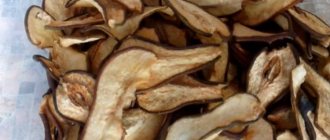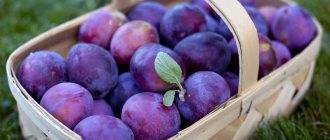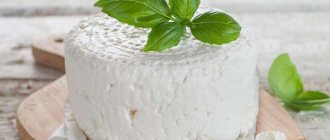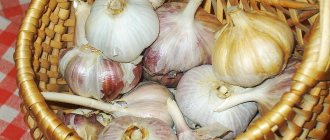Both adults and children love natural sweets, but not everyone knows how to properly store marshmallows. According to the recipe, the delicacy is prepared from seasonal fruits and berries, which do not lose their beneficial qualities during processing, thanks to which the simple product has high nutritional value.
In this article we will tell you how to preserve this popular healthy dessert at home so that it remains tasty and fresh for a long time.
Pastila is prepared from apples, plums, raspberries, strawberries and other berries and fruits
Simple truths: how to store homemade marshmallows for the winter
Having prepared a classic, berry, fruit or any other type of delicacy, many people prefer to eat it right away, without really thinking about storing the marshmallow. However, sometimes there are quite a lot of suitable raw materials, and dried fruit puree becomes the whole family’s favorite sweet. Then the question arises of how to properly preserve this not only tasty, but also healthy product.
Storage conditions for homemade marshmallows
In order for the sweetness to remain as tasty and healthy as immediately after preparation, you will have to follow a few simple rules.
The air humidity in the room where the marshmallow is stored is very important. If the environment is too wet, the marshmallow may leak. It becomes saturated with water and begins to melt, which leads to its complete disrepair, mold and other “charms”. The optimal humidity should be no more than 55-60%. Leaving marshmallow rolls just like that, without any packaging on the shelf, is not a good idea. Firstly, even with moderate humidity, it will soon dry out, lose its primary aroma and taste, and at the same time its beneficial properties.
Storing homemade marshmallows is permissible only within strict temperature limits; this is also important so that the product retains its qualities for a long time. The temperature should range from +12°C to +15°C
You need to preserve the delicacy so that it is not exposed to direct sunlight, which destroys beta-carotene and other beneficial compounds. In addition, under the scorching light, the marshmallow will dry out twice as quickly, becoming unusable. You can’t put the marshmallow for storage next to sharp-smelling foods or substances; it will definitely become saturated with them. Therefore, the product is not stored with spices, tea, coffee, and especially with household chemicals or cleaning products. Ventilation is also a very important factor, since the marshmallow must always be well ventilated. Otherwise, it will “suffocate” and acquire a musty smell.
It doesn’t hurt to immediately cut off any possibility of pests damaging your marshmallow supplies. Rodents and insects readily feast on such sweetness, so it is better to keep it out of their reach.
Correct container for marshmallows
It is very important to devote enough time to choosing the packaging in which the treat will be stored.
- Glass jars with tight, airtight lids are well suited for storing this product. The marshmallows must be placed in them quite tightly, and also securely closed from the penetration of air from the outside.
- Containers with an airtight sealing system are also suitable for marshmallows. However, experienced dryers advise first wrapping each roll of sweets in parchment and only then laying them in layers in a container.
- The most ancient container for storing this ancient Russian delicacy is a wooden box. Its bottom and side walls are laid with several layers of parchment or waxed paper, after which the marshmallow is laid out tightly, and then everything is covered with parchment again. The same rule can be used when choosing a cardboard box for marshmallows.
- Many people prefer to store marshmallows in fabric bags, but for this they will need to be prepared first. A very strong saline solution is diluted in a saucepan (1 glass per liter of water), and pre-washed canvas bags are soaked in it. After 4-6 hours of soaking, they need to be taken out and dried in fresh air, after which they can be slightly shaken to remove excess salt. This treatment will repel insects and rodents, prevent dampness and the development of mold fungi.
Ways to organize apple dessert storage
If all necessary conditions are met, apple pastille can be stored for quite a long time. When prepared well, it should not stain your hands, although it may feel slightly damp to the touch.
If the marshmallow is not completely dry and leaves marks on your hands, you need to dry it in the oven before storing it.
Glass containers
Storing in glass jars is the most common and simplest option, which is very suitable for home use. It can be difficult only if there is a large volume of apple marshmallow, since in this case you will need many cans.
To store in a glass jar, follow these steps:
- The pastila is pre-cut into strips and formed into rolls. Or cut into squares.
- Sprinkle with powdered sugar.
- The resulting pieces are placed in a dry container, layered with parchment.
- Cover with a plastic lid.
Apple marshmallow, unlike a product made from other fruits, such as plums, can have a high density and low plasticity, so it is often more convenient to cut it into squares rather than roll it.
Wooden boxes
Wooden boxes can also be used as places to store apple marshmallows. The prepared container is cleaned, ventilated, dried and lined with parchment, which should cover the bottom and walls of the box. After this, the product is laid, placing all layers with parchment sheets.
If there are large gaps between the boards of the box, the bottom should first be sealed with a sheet of cardboard or plywood.
The disadvantages of this storage method include:
- the need for serious processing of the box itself;
- bulkiness of the container;
- lack of reliability and tightness of such packaging;
- Best suited for large volumes of workpieces.
Canvas bags
To store a dessert product simply in a bag, it needs to be prepared. Only a bag made of linen or cotton non-fading fabric can be used for contact with the product.
Before placing apple marshmallow in it, the bag should be kept in a concentrated saline solution and dried without rinsing.
The marshmallow itself, as in previous storage methods, should be covered with parchment paper. You can store the sweetness directly in such a bag, or by placing it in a tin can.
Disadvantages of the organization:
- the need for additional processing of the bag itself;
- difficulty in laying parchment between rows due to the lack of a rigid shape;
- lack of complete tightness.
Pre-treating the bag with a saline solution will protect the product from insect infestation.
Plastic containers
Apple marshmallows can be stored in airtight containers for more than a month. When laying out the product in layers, you should not forget to separate them with parchment. The containers are compact and take up little space, which is very convenient for home storage.
Only containers intended for food products are suitable for storing marshmallows.
Carton boxes
Cardboard boxes are suitable for storing food products in large quantities. If there are few products, then instead of a box it is better to use glass jars or special containers.
The inside of the cardboard package is lined with parchment, and the layers are separated in the same way as when organizing storage in another container.
If, before placing the marshmallows, the boxes were used for products with a pronounced odor (for example, oranges, tangerines, smoked meats, etc.), they should not be used. In addition, such packaging does not provide complete protection against insects.
The product must not be compacted or placed too tightly, so as not to provoke deformation and damage to the marshmallow.
How not to store
There are a number of conditions under which storing fruit dessert is prohibited. Failure to comply with the rules leads to product damage. Rules for storing marshmallows:
- The fruit treat absorbs all foreign odors. Therefore, it is prohibited to keep it near products with persistent odors.
- It is not recommended to store marshmallows in the refrigerator. Due to a high percentage of humidity, it begins to deteriorate and lose its beneficial properties. Thus, the shelf life is reduced by 2-3 times.
- You should not leave treats in a room where there are a sufficient number of insects. This will lead to spoilage of the dessert and loss of taste characteristics.
- It is not recommended to use plastic bags for storing marshmallows. In them she can inhibit and lose the fruity taste.
- Do not leave the container with the workpiece in a warm and humid room where the air temperature exceeds +18°C. This will lead to spoilage of the dessert, loss of its vitamins and beneficial qualities.
It is worth considering that when defrosting, you should not immediately take the marshmallow out onto the table. A sudden change in temperature can lead to a loss of sweet taste. To begin with, it is recommended to take the treat out of the freezer, move it to the refrigerator shelf and only then serve it.
Making marshmallows at home
After peeling the apples and removing the core, cut the pulp into cubes. Choose those varieties of apples (according to acidity and sucrose content) that you like best in taste. This must be done so that the marshmallow has a pleasant taste and smell for you.
Note: You don’t have to throw away the skins, but dry them, chop them and then add them to black or green tea - it’s very tasty and healthy.
Place the diced apples in a saucepan. Add water. Bring the contents to a boil. Continue to simmer the mixture over low heat until the apples are soft. This takes about ten minutes.
Squeeze lemon juice into the pan and sprinkle cinnamon over the apples. At this stage, you can prepare the apple marshmallow directly in the pan using an immersion blender. But you can use a different type of blender or puree the stewed apples in a food processor.
Then you need to taste the resulting puree. If it is a little sour, add sugar or honey. If it is very sweet, add a little more lemon juice.
So, you have something like an apple-cinnamon mousse, with an excellent taste and smell. Now the decision is yours - eat it all at once or continue preparing the marshmallow. If you've resisted the temptation to eat applesauce, then there's another step ahead.
Line a baking sheet with parchment paper and spread the apple marshmallow mixture onto it in a thin layer.
Place the baking sheet in the oven, on the top shelf. Set the minimum possible temperature - about 60-75 degrees. The layer of apples should dry and stop sticking to your fingers when touched. This will take approximately four to eight hours, maybe longer. It all depends on the set temperature and the thickness of the fruit layer. After removing the baking sheet from the oven, you can leave the marshmallow to ripen for about twelve hours, and only then cut it.
Cut off the overhanging ends of the wax paper and form a long roll from the apple ply and wax paper.
Using a sharp knife or scissors, cut the roll into individual portions.
Tie each portion with a cute string. This will give a festive look to your pastille.
Store homemade marshmallows in a tightly sealed container in the refrigerator for up to two weeks.
When you're ready to treat your guests to a new treat and try it yourself, simply untie the string, separate the marshmallow from the wax paper, and serve it on a plate.
Such cute sweet gifts perfectly lift the mood at any holiday, and not only. You get the whole autumn bouquet of aromas collected in such a small brown roll.
You have the right to deviate a little from the recipe and add your favorite fruits or spices - you definitely won’t spoil the taste. And if you don’t like something, your four-legged friends will be happy to help you “cover up the tracks” of a failed experiment with homemade marshmallows.
Preparation
In order for apples to be stored for a long time, take care of their timely collection and preparation. For long-term storage, choose suitable varieties that are characterized by keeping quality: “Jonathan”, “Olympic”, “Northern Sinap”, etc. Such fruits have a dense peel and retain nutrients, taste and benefits until the next harvest (5-8 months).
When wanting to preserve apples, it is important to know how and when to pick them. Harvest in autumn, in dry, sunny weather.
Pick apples intended for storage carefully so as not to damage the stem or the fruit itself. Start with the lowest branches, gradually moving towards the top of the tree. Carefully place the harvested crop into prepared containers.
Harvest apples in dry, sunny weather. Carefully pick the fruits from the branches, trying not to damage the stalk, and carefully place the fruits in a prepared container
Harvested apples must be kept in a cool room for 2 weeks to identify damaged or diseased fruits.
Then sort the crop. For storage, select only whole, healthy fruits without the slightest signs of damage or rot. Sort the apples by variety and size, and then start storing them for the winter in the chosen way.
Recipe for making Belevsky marshmallow
Initially, you need to make puree from the apples. To do this, the fruits are heat treated and then pureed. There are several ways to do this:
- In the oven. The apples are washed and the wormholes are cut out. Then they are placed on a baking sheet and baked in the oven at 180 degrees until cooked, about 40 minutes. The softened fruit is then rubbed through a sieve to remove seeds and skins.
- On the stove. Apples are cut into quarters and peeled from seeds. Place the slices in a saucepan with 200 milliliters of water added, and simmer them over low heat under a lid until softened. After this, the fruits are pureed with a blender and filtered through a sieve.
- In a slow cooker. Apple slices are completely peeled and seeded. Next, the slices are placed in the multicooker bowl and cooked in the “Baking” mode for 40 minutes. To prevent the fruit from burning, add 50 milliliters of water to the pan. Baked apples are punched with a blender until smooth.
The next step is to beat the applesauce thoroughly. It is convenient to do this with a submersible mixer. Actively whipping the fruit mass should take at least 10 minutes.
After this, half the amount of sugar is introduced into the container with apples in small portions.
Separately, beat the egg white with the second part of the granulated sugar. After running the mixer, stable peaks should form.
The apple puree and whites are combined together and beaten for about 10 minutes, until the mass increases in volume and stops flowing from the spoon.
Approximately 1/5 of the resulting volume is separated. This is the future cream that will be used to lubricate the cakes in the future. To prevent the product from spoiling, it is placed in a jar with a lid and sent to the refrigerator.
The second part of the egg-apple mass is divided in half and placed on baking sheets measuring 20 x 30 centimeters. The layer of mass should be approximately 1 - 2 centimeters. To prevent the marshmallow from sticking, line the surface of the baking sheet with baking paper.
The baking sheets are sent to the oven to dry. The heating temperature should not exceed 80 degrees. The optimal option is 60 – 70 degrees. Drying time – 5 – 8 hours. Required condition: the oven door should be ajar, approximately 2 fingers. Ignoring this point may result in the marshmallow remaining raw.
After the cakes stop sticking to your hands, remove the marshmallow from the oven and let it lie on a flat surface for 2 hours until it cools completely. It is better to place them with the paper facing up.
The cooled cakes are freed from parchment. If the paper does not come off well, you can lightly wet it with water.
Next, the workpieces are lubricated with the previously prepared cream. At the same time, if you plan to make pastila in the form of a roll, then the cakes are not cut. They are simply greased with apple-egg mixture and rolled.
If you plan to form the marshmallow in the shape of a cake, then each cake is cut in half, and then alternately greased and placed on top of each other.
At the final stage, the collected Belevsky apple marshmallow is again sent to the oven for 1.5 - 2 hours. After it has completely dried in the oven, it is allowed to cool at room temperature for 2 - 3 hours.
Top articles: How to store parsley root in the refrigerator
After this, the resulting “cake” is cut into portions, each of which is generously sprinkled with powdered sugar.
Watch the video from the channel “Cooking with Irina Khlebnikova” about the method of preparing Belevsky apple marshmallow at home
How to preserve marshmallows at home: practical tips and tricks
After harvesting apples, pears and plums, housewives prepare jams, jams and compotes. Apples can also be used for other home preservation - tomato sauces, salads and snacks. From the remaining fruits you can prepare a delicious marshmallow for evening tea with your family, and children will also love this delicacy.
Pastila began to be made in Rus' back in the 14th century with the addition of honey and hazelnuts. The form of pastila was very simple - it was boiled in a Russian oven, and then rolled into a thin flat cake, cut, and left for storage.
Properly prepared marshmallow from high-quality raw materials has a dense structure, does not stick to your hands, and does not stick together during storage. But how to store it correctly so that it does not lose its taste and remains appetizing in appearance?
What to consider
Initially, it may seem difficult to preserve marshmallows at home so that they do not lose their original appearance. But if you comply with the storage conditions and do everything correctly, you can keep this healthy treat for a long time without losing its flavor and quality.
Recommended storage:
- Glass jars with tight lids and metal clamps;
- Canvas bags that are placed in tin containers;
- Waxed paper (kitchen parchment, baking paper) and then place the “bag” in a plastic container.
The storage temperature of marshmallows at home should not exceed 15 degrees, and the humidity in the room should preferably be no more than 60%.
To preserve the marshmallow, it must be thoroughly dried; for example, apple-based marshmallow is perfectly stored in a glass container. But for this it is recommended to cut and stack the delicacy.
If the glass container is hermetically sealed, the storage of marshmallows increases to one and a half to two months at optimal temperature and humidity. Well, if you use a canvas bag, then it should be soaked in a strong salt solution and dried without rinsing.
Cellophane bags placed with marshmallows in the refrigerator are not suitable for storage. There, the healthy delicacy will become sticky and shapeless in a few days, and when it comes into contact with air, the marshmallow quickly dries out.
5-6 months after preparation, before enjoying Belevsky marshmallow, it needs to be heated in the oven. Plum marshmallow has a softer consistency, so after cutting, it is recommended to roll it into portioned rolls and store it that way.
Storing the product in winter
Only properly prepared marshmallows will be stored for a long time without losing their appearance, taste or usefulness. The rolled sheet of cooled marshmallow is rolled into a long rope and then cut into portions. All that remains is to place the delicacy in an airtight container, and then the marshmallow can be preserved until the next apple harvest.
Storage temperature
Homemade marshmallows are stored at a temperature of + 13°C -+ 15°C and air humidity of no more than 60%. Before sending it for long-term storage, it is first dried well.
The best way to store apple marshmallow is in a square glass container. The sweetness is cut into rectangular pieces and placed in a container. This marshmallow can be stored for 40–45 days if the temperature is maintained (no higher than +18°C) and humidity is maintained (no more than 65%).
The marshmallow, if it is not packaged, will simply dry out at room temperature, and in the refrigerator, if it is placed in a plastic bag, it will become sticky.
Storage methods
There are many ways to store greens, the main thing is to do the procedure correctly so that all the qualities are preserved as best as possible. The plants are frozen, tinctures are made from it, or they are dried and stored in a container. Drying is done in bunches, or the sheets are laid out separately. The bundles are usually hung.
At room temperature
Mint leaves retain their properties well at room temperature, but the mint is washed and dried before storing. The main thing is to keep the temperature at the same level and not allow air humidity to increase. Sudden changes can cause destruction of the leaves and they will wither. After the procedure, the leaves are kept fresh.
In a refrigerator
Greens keep well for 5 days in a jar of water. To prevent moisture from escaping, cover the container with mint with a transparent bag. For storage up to 10 days, choose food containers. Before that, the greens are washed and dried. Harvesting is carried out in dry weather. Take 2-3 year old plants. A third of the stem is cut off, as the leaves there are the softest and youngest.
In the freezer
This method allows you to preserve nutrients and later use the greens for culinary and medicinal purposes. To do this, take 5-6 branches and put them in regular bags. The bags are then placed in the freezer. The next day, the greens are placed in one bag so that it does not take up much space.
You can also chop the mint before freezing. The chopped plant is placed in containers.
The medicinal plant is frozen in ice cubes, which preserves the tissue well and does not allow the mint to lose its properties. The cubes are put into bags and hidden in a chamber.
Dried
Drying is carried out in dry weather and the temperature is maintained at 22-25 degrees. The leaves are washed and laid out on cloth in separate sheets or twigs. You can also cut into small pieces. To dry, mint is tied into bunches and hung. Choose a place protected from direct sunlight. The plant dries out in a few days.
Growing at home
To always have fresh mint on hand, the plant is planted in a pot. To do this, take a twig and place it in water, wait until it takes root. Then the seedling is transplanted into the soil and watered.
In water
Store chopped mint or leaves in jars. A tincture is made from water. You can also add sugar. But this method has its drawbacks. Although the greens retain their pleasant aroma, they cannot be stored for longer than 3-4 days, as the product begins to deteriorate.
Before the procedure, the leaves are washed and cut. But it depends on the final product and its future use. Pour warm water over the mint and add sugar. Afterwards the container is placed in the refrigerator.
In the towel
After drying, the plants are wrapped in a paper towel. This method will help protect the mint from excess moisture, exposure to sunlight and provide dryness and warmth. Choose a larger towel. In this case, you should not cut the mint, as this will complicate transportation later.
In ice cubes
After the mint has been washed and sorted, it is divided into leaves. Then add water and place the plant in the molds. Next they are sent to the freezer. At subzero temperatures, water will quickly freeze, and the product inside the ice will stay fresh longer.
After you get the mint, you can start cooking. In this form, it is great for salads, as well as brewing tea and infusions. Such preparations are especially relevant for the winter. Greens will help restore vitamins and make you feel energetic. Due to its medicinal properties, it is often used as a cure for colds and flu.
In a cool place
To avoid putting the container in the refrigerator, place it in a cool place, but it is important to keep the temperature at the same level. Humidity should also not be high
mint sugar
To do this, you only need two products: mint and sugar. This sweet addition will complement desserts well. The product has a well-defined sweet aroma. It is often added to coffee and tea to add flavor. You can also add mint sugar to sauces and dressings, sprinkle it on berries and yogurts. Add this product at the end of cooking so that it does not lose its taste.
Take fresh mint, wash it and cut it. Throw away the twigs immediately, make sure you don’t get any limp leaves, otherwise the sugar will quickly spoil. After 30 grams of mint, mix with 150 grams of sugar. This makes one serving. Gradually the mint will soak in the juice and turn into puree. Store sugar in well-closed containers. This storage method does not take much time, and the final product can be used beneficially.
Limit shelf life of different types and recommendations from experienced
How long to store marshmallows
An important question for many is also how long homemade marshmallows last. After all, not all the prepared product is always eaten quickly, and any housewife wants to stretch out the pleasure throughout the winter. A lot depends on the components from which the sweetness is made.
- Belevskaya marshmallow, made from apples, sugar and egg whites, can last in an airtight container for no more than 1-2 months, after which it is no longer worth eating. However, in a deep freezer it will retain its properties for 10-12 months.
- All types of marshmallows, which contain only fruit or berry puree, as well as sugar, can last much longer. The approximate shelf life in bags or cardboard boxes is 2-3 months, and in sealed containers 4-5 months. In the freezer the period will be approximately 1-1.5 years.
Simple tips from experienced people
Preserving such a healthy delicacy for a long time is not an easy task, but you will not regret if you make an effort and devote time to this issue. After all, then you can save it until the next harvest, all winter and especially spring, enjoying the pleasant taste and delicate aroma. It’s worth considering a few more simple tips from experienced dryers who know exactly what to do.
- In order for the marshmallow to be stored longer (just not in deep freezing), it should be periodically removed from the packaging and dried. This can be done over 1-2 days outdoors if suitable conditions exist. However, it is best to dry the marshmallow in the oven for 2-3 hours at a temperature of 50-60°C or in a dehydrator (electric dryer) at 40-45°C for 4-5 hours. However, this should only be done if you see that the product is damp, otherwise there is a danger of drying it out.
- Any type of marshmallow can significantly extend its shelf life if stored in sugar. To do this, you will need a glass jar or a wooden box without grooves or holes. The bottom is lined with wax paper or parchment, and a layer of powdered sugar is spilled on top. Then a layer of marshmallow is laid, again a layer of powdered sugar, and so on until the very top, so that the top marshmallow is necessarily sprinkled with sugar.
- As an option for storing in sugar, you can use the following method. As soon as the pastille dries using any drying method, heat it slightly in the oven. Then remove from the baking sheet, pour powdered sugar onto the table, generously sprinkle one side of the treat and thoroughly rub it into the surface. Then turn the sheet over and repeat the manipulations. Roll the product into a roll, cut into portions and send for storage - the period will last for 3-5 weeks.
If you urgently need to send the marshmallow for storage, but don’t have powdered sugar on hand, you can prepare it yourself. Moreover, it can be obtained from ordinary sand, brown sand, and even from refined sugar. To do this, grind the sugar using a coffee grinder and that’s it, the powder can be used for any purpose.
Previous Useful informationCandied fruits - a healthy delicacy of the East Next Useful informationSweet candied pineapple fruits: the benefits and harms of the delicacy
Packaging, labeling and storage of marshmallows
Pastille products are produced by the piece, by weight or packaged.
Marshmallows and glue marshmallows are packaged in boxes made of cardboard with a net weight of no more than 1000 g, bags or packs with a net weight of no more than 250 g, wrapped in cellophane, a label, a label with a wrap. For labels and wrappings, label and writing paper, polymer and other packaging materials are used, the use of which is permitted by the State Sanitary and Epidemiological Supervision authorities.
When packing in boxes, it is allowed to place chocolate-covered marshmallows in capsules made of label paper.
Sets and mixtures of pastille products or pastile products in combination with marmalade must be packed in boxes with a net weight of no more than 2000 g. The bottom of the boxes and the surface of the pastile products packaged in them are covered with wrapping paper, sub-parchment, parchment, waxed paper, cellophane. When placing pastille products in correxes or capsules, the bottom of the boxes is not covered.
Flavored pastille products (marshmallows and glue pastilles) are placed in clean wooden boxes, reusable boxes or corrugated cardboard boxes with a net weight of no more than 6 kg. Marshmallows are laid in no more than three rows, glue marshmallows in no more than 6 rows.
The custard pastille is placed in wooden boxes with a net weight of no more than 7 kg, and is also packaged in boxes with a net weight of up to 500 g.
Boxes and boxes are lined with wrapping paper, parchment, sub-parchment, waxed paper and cellophane. The same materials are used to lay pastille products between the rows.
Permissible deviations in the net weight of a packaging unit of pastille products are, in %, no more than:
Minus 10.0 from the average weight of 20 pieces of products – when packing piece products;
Minus 8.0 from the average weight of 10 pieces of packaging units - when packed up to 100 g inclusive;
Minus 5.0 from the average weight of 10 pieces of packaging units - for packaging over 100 g up to 300 g inclusive;
Minus 1.0 from the average weight of 10 pieces of packaging units - for packaging over 1000 g.
When packaging pastille products by weight, a net weight deviation of minus 1.0% is allowed. The deviation of the net mass according to the upper limit is not limited.
On consumer packaging of all types (boxes, packs, etc.) with pastille products indicate: the trademark and name of the manufacturer, its location; Product name; compound; net weight; production date; information about certification (valid in the Russian Federation); shelf life; expiration date (valid in the Russian Federation); information about the nutritional and energy value of 100 g of product; designation NTD.
When packaging pastille products in boxes, bags and packs with a net weight of less than 200 g, it is allowed not to indicate the production date and shelf life.
In boxes with pastille products with a net weight of more than 250 g, put a label with the stacker number or put the stacker number on the outside of the box.
Transport marking - with the application of handling marks: “Fragile
Caution!”, “Keep away from moisture”, “Keep away from heat”
Each unit of transport container is marked with a marking that characterizes the product: trademark and name of the manufacturer, its location; Product name; net weight; number of packaging units and weight of the packaging unit (for packaged products); production date; shelf life; designation NTD.
A label with the number of the stacker or shift is placed inside the boxes with pastille products, or the number of the stacker or shift is stamped on the outside of the container.
Pastille products are transported by all types of transport in covered vehicles in accordance with the cargo transportation rules in force for each type of transport.
Pastila products should be stored in clean, well-ventilated rooms, not infested with pests of grain stocks, at a temperature of 15-21 degrees and RHV not more than 75%.
The shelf life of pastille products under the specified storage and transportation conditions from the date of manufacture is established as follows:
1 month – for marshmallows and glue marshmallows, marshmallows in chocolate;
3 months – for custard marshmallows in chocolate, produced on an automated line;
14 days – for “Bananas” marshmallows.
Cooking from pulp after juicer
After preparing apple juice using a juicer, there is always some pulp left over, which we most often throw away. However, it’s better to put it to work and make delicious homemade marshmallows.
The calorie content of such a dish will be approximately 295 kcal/100 g. You will need apples, sugar and water to prepare the puree.
Preparation:
- Take the apple pulp, separate the skins and discard them.
- Prepare applesauce from the pulp according to the recipes above. It is best to choose manual grinding through a sieve, as this will prevent even the smallest seeds and skins from getting into the puree.
- Pour the puree onto a baking sheet or into a tray and dry it in a way convenient for you: in the oven or electric dryer.
A juicer will also help speed up the process of preparing marshmallows. Steamed apples will be an excellent base for making puree according to one of the above recipes. In this case, we recommend using a blender, it will help achieve the most homogeneous mass.
Next, place the puree in containers or a baking sheet with foil, distribute the mixture evenly and place in the oven or electric dryer for 7-8 hours until completely dry.
Everyone will be happy with this sweetness, because it contains only 295 kcal/100 g, and all the benefits for the body cannot be listed.
What to do with dried marshmallows? How to soften it?
If the marshmallow has not petrified to such an extent that it will in no way yield to the efforts of cutting it into several pieces, then it is still possible to make a marshmallow cake from it. You need any fruits, nuts, and cream, whipped with sugar.
Cut each marshmallow half in half or into 3 pieces horizontally. It is convenient to cut with a knife dipped in hot water. Place some of the marshmallow plates on a plate, pour over the whipped fruit, sprinkle with chopped nuts, and place a layer of any chopped fruit. Repeat










